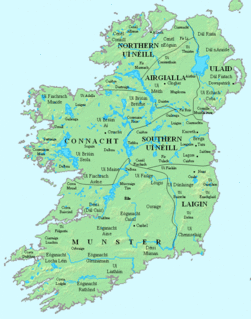
Uí Mháine, often Anglicised as Hy Many, was one of the oldest and largest kingdoms located in Connacht, Ireland. Its territory of approximately 1,000 square miles (2,600 km2) encompassed all of what is now north, east and south County Galway, south and central County Roscommon, an area near County Clare, and at one stage had apparently subjugated land on the east bank of the Shannon, together with the parish of Lusmagh in Offaly.

The Book of Leinster, is a medieval Irish manuscript compiled c. 1160 and now kept in Trinity College, Dublin, under the shelfmark MS H 2.18. It was formerly known as the Lebor na Nuachongbála "Book of Nuachongbáil", a monastic site known today as Oughaval.
Cóiced Ol nEchmacht is an ancient name for the province of Connacht, Ireland.

Cainnech of Aghaboe (515/16–600), also known as Saint Canice in Ireland, Saint Kenneth in Scotland, Saint Kenny and in Latin Saint Canicus, was an Irish abbot, monastic founder, priest and missionary during the early medieval period. Cainnech is one of the Twelve Apostles of Ireland and preached Christianity across Ireland and to the Picts in Scotland. He wrote a commentary on the Gospels, which for centuries was known as the Glas-Choinnigh or Kenneth's Lock or the Chain of Cainnech.

Saint Colmán of Cloyne, also Colmán mac Léníne, was a monk, founder and patron of Cluain Uama, now Cloyne, County Cork, Ireland, and one of the earliest known Irish poets to write in the vernacular.

Corcomroe is a barony in County Clare, Ireland. It is the southern half of the Gaelic tuath of Corco Modhruadh.
Saint Molua, , was an Irish saint, who was a Christian abbot in the Early Middle Ages. Saint Molua's feast day is on 4 August. He is venerated in the Catholic Church and Orthodox Church.

The Senchineoil was the name of the early rulers, possibly pre-Gaelic, of what is now central and east County Galway and south County Roscommon, Ireland.
Guaire Aidne mac Colmáin was a king of Connacht. A member of the Ui Fiachrach Aidhne and son of king Colmán mac Cobthaig. Guaire ruled at the height of Ui Fiachrach Aidne power in south Connacht.
Indrechtach mac Muiredaig Muillethan was a King of Connacht from the Uí Briúin branch of the Connachta. He was the son of Muiredach Muillethan mac Fergusso, a previous king. He was of the Síl Muiredaig sept of the Uí Briúin.
The Synod of Birr, held at Birr in modern County Offaly, Ireland in 697 was a meeting of churchmen and secular notables. Best remembered as the occasion on which the Cáin Adomnáin—the Law of Innocents—was guaranteed, the survival of a list of the guarantors of the law sheds some light on the synod.
Events from the 7th century in Ireland.
Colman Cass mac Fualascaig, 10th Abbot of Clonmacnoise, died 665.
Flannchad ua Ruaidine was the 53rd Abbot of Clonmacnoise.

Saint Mo Chutu mac Fínaill, also known as Mochuda, Carthach or Carthach the Younger, was abbot of Rahan, County Offaly and subsequently, founder and first abbot of Lismore, County Waterford. The saint's Life has come down in several Irish and Latin recensions, which appear to derive from a Latin original written in the 11th or 12th century.
The Uí Fiachrach were a royal dynasty who originated in, and whose descendants later ruled, the coicead or fifth of Connacht at different times from the mid-first millennium onwards. They claimed descent from Fiachrae, an older half-brother of Niall Noigiallach or Niall of the Nine Hostages. Fiachrae and his two full brothers, Brion and Ailill, were the collective ancestors of the Connachta dynasty that eventually became the new name of the province. Their mother was Mongfind.
Ó Troighthigh is a Gaelic-Irish surname, meaning descendant of foot-soldier.
The Corca Oíche, meaning "the race of Oíche" was an ancient tribe, possibly of Pictish origin, existing since pre-Christian times in Ireland. It is possible that they descend from the Cruthin, a people whose territory existed near Lough Neagh in north-east Ireland. As such, some sources claim that they descended from the semi-legendary hero Dubthach Dóeltenga, or more commonly that they are descended from Oíche or Óchae, the daughter of Cronn Badhraoi of the Dál nAraidi, and her son Fergus Foga last king of the Ulaid to rule at Emain Macha.





